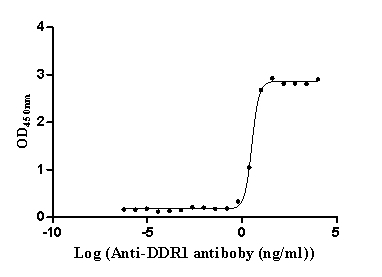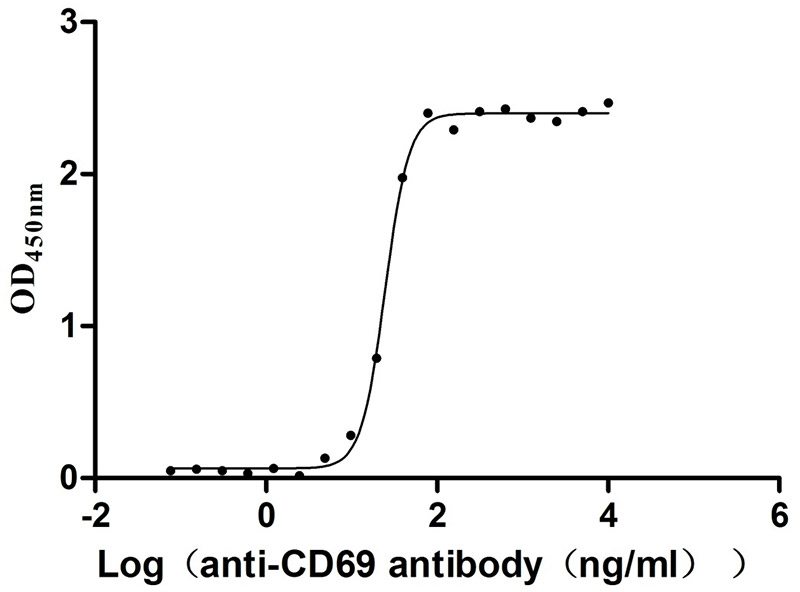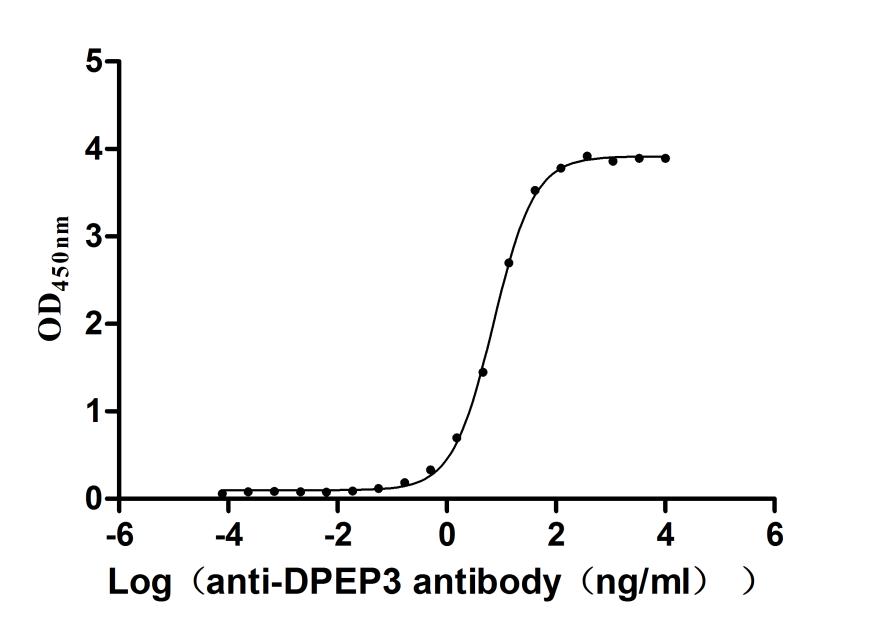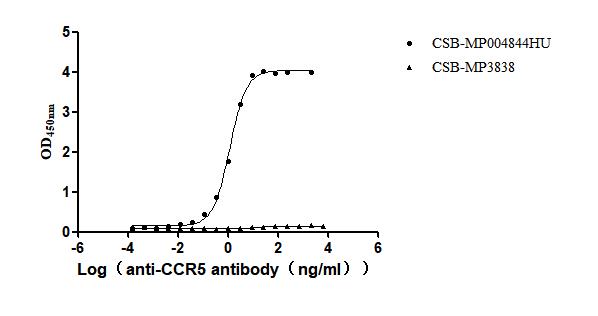Recombinant Human Toll-like receptor 7 (TLR7), partial
-
中文名稱:人TLR7重組蛋白
-
貨號:CSB-YP023606HU
-
規(guī)格:
-
來源:Yeast
-
其他:
-
中文名稱:人TLR7重組蛋白
-
貨號:CSB-EP023606HU-B
-
規(guī)格:
-
來源:E.coli
-
共軛:Avi-tag Biotinylated
E. coli biotin ligase (BirA) is highly specific in covalently attaching biotin to the 15 amino acid AviTag peptide. This recombinant protein was biotinylated in vivo by AviTag-BirA technology, which method is BriA catalyzes amide linkage between the biotin and the specific lysine of the AviTag.
-
其他:
-
中文名稱:人TLR7重組蛋白
-
貨號:CSB-BP023606HU
-
規(guī)格:
-
來源:Baculovirus
-
其他:
-
中文名稱:人TLR7重組蛋白
-
貨號:CSB-MP023606HU
-
規(guī)格:
-
來源:Mammalian cell
-
其他:
產(chǎn)品詳情
-
純度:>85% (SDS-PAGE)
-
基因名:
-
Uniprot No.:
-
別名:PRO285; TLR 7; Tlr7; TLR7_HUMAN; Toll like receptor 7; Toll-like receptor 7; UNQ248
-
種屬:Homo sapiens (Human)
-
蛋白長度:Partial
-
蛋白標簽:Tag?type?will?be?determined?during?the?manufacturing?process.
The tag type will be determined during production process. If you have specified tag type, please tell us and we will develop the specified tag preferentially. -
產(chǎn)品提供形式:Lyophilized powder
Note: We will preferentially ship the format that we have in stock, however, if you have any special requirement for the format, please remark your requirement when placing the order, we will prepare according to your demand. -
復溶:We recommend that this vial be briefly centrifuged prior to opening to bring the contents to the bottom. Please reconstitute protein in deionized sterile water to a concentration of 0.1-1.0 mg/mL.We recommend to add 5-50% of glycerol (final concentration) and aliquot for long-term storage at -20℃/-80℃. Our default final concentration of glycerol is 50%. Customers could use it as reference.
-
儲存條件:Store at -20°C/-80°C upon receipt, aliquoting is necessary for mutiple use. Avoid repeated freeze-thaw cycles.
-
保質(zhì)期:The shelf life is related to many factors, storage state, buffer ingredients, storage temperature and the stability of the protein itself.
Generally, the shelf life of liquid form is 6 months at -20°C/-80°C. The shelf life of lyophilized form is 12 months at -20°C/-80°C. -
貨期:Delivery time may differ from different purchasing way or location, please kindly consult your local distributors for specific delivery time.Note: All of our proteins are default shipped with normal blue ice packs, if you request to ship with dry ice, please communicate with us in advance and extra fees will be charged.
-
注意事項:Repeated freezing and thawing is not recommended. Store working aliquots at 4°C for up to one week.
-
Datasheet :Please contact us to get it.
相關(guān)產(chǎn)品
問答及客戶評論
Regarding your protein CSB-EP023606HU, could you please advise on the lead time, the sequencing,and the expected tag information for all 4 expression hosts?
Recombinant Human Toll-like receptor 7(TLR7) ,partial
CSB-YP023606HU >> Yeast
CSB-EP023606HU >> E.coli
CSB-BP023606HU >> Baculovirus
CSB-MP023606HU >> Mammalian cell
Expression Region: 861-1049aa; Partial, provide the complete cytoplasmic domain.
Tag information:EP: N-terminal 10xHis-tagged and C-terminal Myc-tagged; YP, BP, MP: Tag type will be determined during the manufacturing process.
The expected tag for other expression system: YP: N-terminal 6xHis-tagged; BP, MP: N-terminal 10xHis-tagged and C-terminal Myc-tagged.
Sequence:
HLYFWDVWYIYHFCKAKIKGYQRLISPDCCYDAFIVYDTKDPAVTEWVLAELVAKLEDPREKHFNLCLEERDWLPGQPVLENLSQSIQLSKKTVFVMTDKYAKTENFKIAFYLSHQRLMDEKVDVIILIFLEKPFQKSKFLQLRKRLCGSSVLEWPTNPQAHPYFWQCLKNALATDNHVAYSQVFKETV
Thank you very much for this information.
Do you have the same sequence for the cytoplasmic domain in the mouse TLR7?
Recombinant Mouse Toll-like receptor 7(Tlr7) ,partial
CSB-YP023606MO1 >> Yeast
CSB-EP023606MO1 >> E.coli
CSB-BP023606MO1 >> Baculovirus
CSB-MP023606MO1 >> Mammalian cell
Expression Region: 859-1050aa; Partial, provide the complete cytoplasmic domain.
Tag information:EP, YP, BP, MP: Tag type will be determined during the manufacturing process.
The expected tag for each expression system is listed as follows:
YP: N-terminal 6xHis-tagged; EP, BP, MP: N-terminal 10xHis-tagged and C-terminal Myc-tagged.
Sequence:
TTSHLFFWDMWYIYYFWKAKIKGYQHLQSMESCYDAFIVYDTKNSAVTEWVLQELVAKLEDPREKHFNLCLEERDWLPGQPVLENLSQSIQLSKKTVFVMTQKYAKTESFKMAFYLSHQRLLDEKVDVIILIFLEKPLQKSKFLQLRKRLCRSSVLEWPANPQAHPYFWQCLKNALTTDNHVAYSQMFKETV
Reference: https://www.uniprot.org/uniprot/P58681
In addition, we have developed another region of this protein, pls check the below information for your reference:
Recombinant Mouse Toll-like receptor 7(Tlr7),partial
CSB-YP023606MO >> Yeast
CSB-EP023606MO >> E.coli
CSB-EP023606MOb1 >> E.coli
CSB-BP023606MO >> Baculovirus
CSB-MP023606MO >> Mammalian cell
Expression Region: 27-348aa; Provide the fragment of the extracellular domain at the N-terminal.
Tag information:CSB-EP023606MO: N-terminal GST-tagged; CSB-EP023606MOb1: N-terminal 10xHis-tagged and C-terminal Myc-tagged;
MP: N-terminal 10xHis-tagged and C-terminal Myc-tagged
The expected tag for other expression system: YP: N-terminal 6xHis-tagged; BP: N-terminal 10xHis-tagged and C-terminal Myc-tagged.
Sequence:
FRWFPKTLPCEVKVNIPEAHVIVDCTDKHLTEIPEGIPTNTTNLTLTINHIPSISPDSFRRLNHLEEIDLRCNCVPVLLGSKANVCTKRLQIRPGSFSGLSDLKALYLDGNQLLEIPQDLPSSLHLLSLEANNIFSITKENLTELVNIETLYLGQNCYYRNPCNVSYSIEKDAFLVMRNLKVLSLKDNNVTAVPTTLPPNLLELYLYNNIIKKIQENDFNNLNELQVLDLSGNCPRCYNVPYPCTPCENNSPLQIHDNAFNSLTELKVLRLHSNSLQHVPPTWFKNMRNLQELDLSQNYLAREIEEAKFLHFLPNLVELDFS
靶點詳情
-
功能:Endosomal receptor that plays a key role in innate and adaptive immunity. Controls host immune response against pathogens through recognition of uridine-containing single strand RNAs (ssRNAs) of viral origin or guanosine analogs. Upon binding to agonists, undergoes dimerization that brings TIR domains from the two molecules into direct contact, leading to the recruitment of TIR-containing downstream adapter MYD88 through homotypic interaction. In turn, the Myddosome signaling complex is formed involving IRAK4, IRAK1, TRAF6, TRAF3 leading to activation of downstream transcription factors NF-kappa-B and IRF7 to induce proinflammatory cytokines and interferons, respectively.
-
基因功能參考文獻:
- Enhanced TLR7 expression owing to biallelism contributes to the higher risk of developing SLE. PMID: 29374079
- Btk acts in the TLR7/8 pathway and mediates Ser-536 phosphorylation of p65 RelA and subsequent nuclear entry in primary human macrophages. PMID: 29567473
- the miRNA profile did not significantly differ between SLE and APS, but was driven by the presence or absence of an IFN signature. TLR7 stimulation induced a general downregulation of miRNAs, similar to the pattern observed in SLE and APS patients. PMID: 29873766
- TLR7 upregulation has a role in liver cancer cell proliferation involving lipid rafts PMID: 27588480
- Study demonstrates that Hepatitis C virus (HCV) genomic RNA harbours specific sequences that initiate an anti-HCV immune response through TLR7 and TLR8 in various antigen presenting cells. PMID: 27385120
- TLR7, TLR9, and JAK2 genes are potential biomarkers for systemic sclerosis. High TLR7 expression positively correlated with the late form of disease. Decreased levels of TLR9 and JAK2 mRNA were found in the patient's cohort in comparison to non-SSc individuals. PMID: 29147913
- The results indicate that TLR7 up-regulation is related to Respiratory syncytial virus infection and the induction of oxidative stress and that TLR7 expression was mediated by the anti-inflammatory effects of Nrf2/ARE pathway inhibitors or agonists. PMID: 29392496
- Thus, TLR7 and TLR8 might modulate different immune responses in monocytes and macrophages. PMID: 29448098
- Positive rates of iNOS in cervical tissues were 72.1%, 28.2%, and 3.1% in the -HPV-positive patients with cervical cancer (CC group), HR-HPV group, and controls, respectively (P < 0.05). Levels of TLR3, TLR4, TLR7, TLR8, NF-kappaB p65, and iNOS in cervical epithelial cells were higher in CC group than in other groups. PMID: 28626766
- Data suggest a central role of XBP1 in TLR7-induced IFNalpha production and identify XBP1 as a potential novel therapeutic target in IFNalpha-driven autoimmune and inflammatory diseases. PMID: 28408069
- These findings suggest that increased EV71 and CA16 replication meditated by autophagy in 16HBE cells might promote degradation of the endosome, leading to suppression of the TLR7-mediated IFN-I signaling pathway. PMID: 29052054
- The present study investigated the effects of vitamin D3 on the expression of TLR3, TLR7, and TLR9 in Systemic lupus erythematosus patients. PMID: 28544067
- findings indicate that hepatitis C virus induces CD4 T cell impairment via TLR7 which may contribute to failure of virus eradication, casting doubts on the use of TLR7 agonists to boost innate immunity in chronic RNA virus infections. PMID: 27876497
- TLR 5, 7, and 9 expression patterns differed between HPV-positive and -negative oropharyngeal squamous cell carcinoma patients. In HPV-positive tumors the expression of TLR 5 and 7 correlated with tumor recurrence. PMID: 28856441
- Low TLR7 copy number is a risk factor for chronic hepatitis B virus infection but is not associated with later stages of disease progression PMID: 28321161
- TLR7 and TLR8 genetic polymorphisms are associated with susceptibility to mycobacterium tuberculosis infection, and the link is shaped by less effective MTB phagocytosis and impaired TLR signaling. PMID: 27156628
- Study evaluated innate immune profiles following TLR stimulation in HIV-1-infected mothers and newborns, found significantly compromised cytokine responses upon extracellular and intracellular TLR activation. Myeloid dendritic cell (DC) responsiveness appeared to be less impaired than plasmacytoid DCs, and might be enhanced through TLR7/TLR8 activation. PMID: 23826189
- This is the first study illustrating certain genotypes of TLR-7 and TLR-8 single nucleotide polymorphisms viz. CT(p = 0.002)]; rs3853839[GC(p < 0.001), CC(p = 0.039)] and rs3764879[GC(p < 0.001)] were considerably associated with Chikungunya virus susceptibility. PMID: 28888110
- study demonstrates that activation of TLR7 signaling in T cells can inhibit Th17 cell differentiation from naive T cells and IL-17 production in established Th17 cells; further report that downregulation of STAT3 signaling is responsible for TLR7-mediated inhibition of Th17 cells due to induction of suppressor of cytokine signaling 3 and 5 PMID: 28652396
- Data indicate a mechanism in which Toll-like receptors TLR7/8 signaling, through shedding of FcgRIIA, shifts neutrophil function from phagocytosis to a programmed necrosis pathway, neutrophil extracellular trap formation (NETosis). PMID: 28606989
- TLR7 is abundantly expressed in human atherosclerotic plaques. TLR7 ligation elicits the secretion of pro-inflammatory and anti-inflammatory cytokines, and high TLR7 expression in plaques is associated with better patient outcome. PMID: 27864310
- this study identified TLR7 as mediator of monocyte differentiation and M2 macrophage polarization during hepatitis C virus infection PMID: 28122964
- Increased susceptibility to autoimmune is associated with single nucleotide polymorphisms and copy number variations of Toll like receptor 7. [review] PMID: 28397237
- COPD lung tissue explants showed a greater pro-inflammatory response to TLR3 or TLR7/8 activation than control smokers. PMID: 27729782
- the activation of TLR7 increased CCND3 expression via the downregulation of miR-15b in B cells. PMID: 26144250
- TLR9 and TLR7 were upregulated both at the mRNA and the protein levels in wounds of type 2 diabetes mellitus patients compared with the non-diabetic patients and may lead to an unresolved inflammatory response and non-healing chronic ulcers. PMID: 25586463
- This study suggests that deliberate control of TLR signaling is a key factor in the success of mRNA-driven cellular reprogramming. PMID: 27586271
- changes in mRNA expression of selected toll-like receptors (TLR2, TLR4, TLR7), stress cytokine prolactin (PRL), and proand anti-inflammatory cytokines (TNF-alpha, IL-6, IL-12, IL-10) in peripheral blood monocytes of celiac disease patients, were investiagted. PMID: 28028951
- The ER-stress inducing property of IMQ is possibly of importance for its efficacy in treating basal cell carcinoma, in situ melanoma, and squamous cell carcinoma. Our data could potentially be harnessed for rational design of even more potent ER-stress inducers and new anti-cancer drugs. PMID: 27003259
- TLR8 polymorphisms were associated with an increased risk and TLR7 polymorphisms with a decreased risk of recurrent rhinovirus infections. PMID: 28403045
- We found lower expression levels of TLR1, TLR3, TLR4, TLR7 and TLR9 in PBMCs from patients with ALL compared with those from control patients. We also observed that the PBMCs from patients with Pre-B and B ALL had lower TLR4 expression than controls PMID: 27277333
- interferon alpha (IFN-alpha) secretion induced by Toll-like receptor 7 and Toll-like receptor 8 (TLR7/TLR8) activation was observed in common variable immunodeficiency (CVID), which was recovered with Toll-like receptor 9 (TLR9) signaling. PMID: 27392462
- this study shows that TLR7 gene polymorphism is associated with susceptibility to HIV and HCV co-infection PMID: 28062211
- TLR7 gene rs2897827 may influence TLR7 mRNA expression and the plasma ApoA1 level in male ischemic stroke patients. PMID: 27427388
- Considering that chronic hepatitis B infection is not yet curable, it could be possible to activate TLR7-related immunological pathways as a therapy directed towards persistent HBV infection PMID: 27373425
- Both TLR 5 and 7 are expressed in salivary adenoid cystic carcinoma on the cell membranes as well as in cytoplasm. PMID: 26888781
- human Toll-like receptor 7 ligand binding domain PMID: 25817271
- TLR7 mRNA expression was significantly elevated in patients with relapsing remitting multiple sclerosis. PMID: 26996115
- Our meta-analysis suggests that TLR7, TLR8, and TLR9 polymorphisms are associated with the development of systemic lupus erythematosus in Caucasian, Asian, and African populations PMID: 26762473
- activation of TLR7 upregulated the expression levels of IFN-lambda1 and MMP-9 were increased by ~3 fold, whereas other genes (p53, PTEN, TIMP-1) were upregulated by ~2 fold, and VEGF was marginally upregulated after 10 min. PMID: 26718740
- Increased expression of TLR7 and TLR9 in myasthenia gravis thymus is accompanied by active Epstein-Barr virus infection. PMID: 26723518
- The low expression of TLR-7 in tumour and high expression of TLR-7 in stroma predict a good clinical outcome for oral squamous cell carcinoma patients PMID: 25828894
- TLR7 and 8 polymorphisms may play a considerable role in the pathogenesis of asthma. PMID: 26725554
- NADPH oxidase-deficient patient-derived B cells also expressed enhanced levels of TLR7 and TLR9 mRNA and protein compared with the same cells reconstituted to restore oxidase activity. PMID: 26340429
- Data show that differences in codon bias limit Toll-like receptor 7 (TLR7) expression relative to Toll-like receptor 9 (TLR9). PMID: 26903634
- Activation of TLR7 suppresses the progression of pancreatic cancer. PMID: 26238718
- Results show that TLR7 and TLR8 on trophoblastic cells play an important role in the prevention of intrauterine HBV transmission by inhibiting HBV translocation across trophoblasts. PMID: 26315138
- In females, the incidence of the X-linked TLR7 rs179008/Gln11Leu polymorphism was significantly lower in sarcoidosis patients. PMID: 24071890
- A key regulatory cytokine found increased upon TLR7 stimulation. PMID: 25923141
- This study established a correlation between miR-155 and TLR7 during hepatitis B virus infection and also demonstrated in vitro that increased miR-155 level could help to reduce viral load by targeting C/EBP-beta. PMID: 25720442
顯示更多
收起更多
-
亞細胞定位:Endoplasmic reticulum membrane; Single-pass type I membrane protein. Endosome. Lysosome. Cytoplasmic vesicle, phagosome.
-
蛋白家族:Toll-like receptor family
-
組織特異性:Detected in brain, placenta, spleen, stomach, small intestine, lung and in plasmacytoid pre-dendritic cells. Expressed in peripheral mononuclear blood cells.
-
數(shù)據(jù)庫鏈接:
Most popular with customers
-
Recombinant Human Semaphorin-4D (SEMA4D), partial (Active)
Express system: Mammalian cell
Species: Homo sapiens (Human)
-
Recombinant Human Poliovirus receptor (PVR) (I340M), partial (Active)
Express system: Mammalian cell
Species: Homo sapiens (Human)
-
Recombinant Human Epithelial discoidin domain-containing receptor 1 (DDR1), partial (Active)
Express system: Mammalian cell
Species: Homo sapiens (Human)
-
Recombinant Human Early activation antigen CD69 (CD69), partial (Active)
Express system: Mammalian cell
Species: Homo sapiens (Human)
-
Recombinant Human Killer cell immunoglobulin-like receptor 3DL2 (KIR3DL2), partial (Active)
Express system: Mammalian cell
Species: Homo sapiens (Human)
-
Recombinant Human Dipeptidase 3(DPEP3), partial (Active)
Express system: Mammalian cell
Species: Homo sapiens (Human)
-
Recombinant Human C-C chemokine receptor type 5 (CCR5)-VLPs (Active)
Express system: Mammalian cell
Species: Homo sapiens (Human)



-AC1.jpg)















